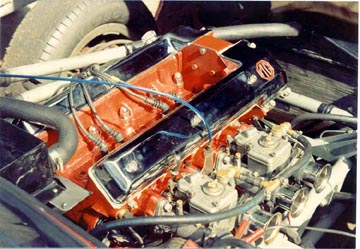all thing being equal.. a lets say.... a 2 liter engine, with the same bore and stroke.. the lift and durration of the cam.. would it not work the same in a 2 liter 4 cly cars, with the same bore and stroke? same hp and tq curve?
all thing being equal.. a lets say.... a 2 liter engine, with the same bore and stroke.. the lift and durration of the cam.. would it not work the same in a 2 liter 4 cly cars, with the same bore and stroke? same hp and tq curve?
In reply to Alfaromeoguy :
No. Specifications would make a difference. For example 4 valves per cylinder? Port flow numbers being different, compression, bore vs stroke. Induction etc.
But you are on the right path. I use Offenhauser cam profiles because they have a 4.25 stroke to Jaguars 4.17 stroke. And the heads flow nearly similar numbers.
I also use Ford Flathead masters because like an overhead camshaft they have a 1-1 cam lift to valve lift ratio.
Now exactly which I use depends on how I will be using it.
Two cam grinds with the "same" lift and duration can be very, very different. In addition how the cams and the ports and the manifolds, and the throttle and exhaust all interact which leads to additional differences. Even valve angle and port entry angle can make or break hp and show differences between engines that look very similar on paper (VW 16v upright exhaust valves, I am looking at you!)
In reply to Alfaromeoguy :
You will be very close. Most of the tuning between engines is related to intake valve opening timing, overall port energy and pulse wave tuning. You may end up with a different length intake runner or exhaust collector. And different overlaps. But it should be very similar.
In my opinion
Sometimes yes, sometimes no. But sometimes it is the only shot to take.
I built a race only engine based on a quite rare MG - the MGA Twin Cam, which was a DOHC 1588 cc engine made in 1958 that put out 108 bhp @ 6900 rpm. They built around 2000 of them.
Mine was grafted onto a much modified 5 main bearing MGB pushrod block, had a a lot of head work including larger valves, 12:1 compression and 1950 ccs. I didn't have a dyno to spend time on, so I had to make an educated guess as to what cam timing might work. I did it by comparison with similar engines and went with the Cosworth L1 profiles developed for the DOHC Ford four cylinder race engines (Alfa would have been another one to look at).
It worked - after I sorted out a couple of 45 DCOEs on it and a bunch of other things, but I was a bit lucky in that I didn't experience any of the quirks that could have not worked as well and would have left me scratching my head and out of pocket. (PS - this was around 1979)

While they would work the power output could vary wildly.
Example: on my Datsun I use Keihin 39mm flat slide carbs, the are a downdraft (45 degree angle), with the throttle slide fully open you can actually see the valve head and a portion of the seat. The intake pulses for that are going to behave very differently than if it were equipped with DCOE carbs. The head flows a lot more with the Keihin carbs.
The RPM where the torque peaks will be very similar, but all bets are off when it comes to how the actual engine handles things.
Port flow? Valve size and configuration? Chamber design? Quench? Exhaust style? fuel trim? rocker/follower ratio? Intake manifold design and how it manages heat? All of those things can vastly affect actual engine output.
I've done this before on dyno sim software. I worked up a whole profile for a Buick 455 I was building. I input the head flows at various lift points, tweaked valve sizes, carefully put in cam numbers, compression, etc. I came up with a relatively accurate estimate. Then (leaving absolutely everything else alone) I changed the engine to an Olds 455. The simulation curves were 100% identical down to the exact HP and TQ values at every point.
In reality, we all know that bore and stroke doesn't change much with regard to HP/TQ. Displacement does. In the real world, the Olds 455 wouldn't make the same exact curves as a Buick 455 because the Olds has small bores, terrible head geometry, and really inefficient chambers.
So, if you put the same exact cam lobes in a 10:1 2.0L VW, you will get completely different numbers if you put the same lobes in a 10:1 2.0L Ford Duratec Zeta. Many thousands of factors involved.
You'll need to log in to post.